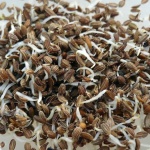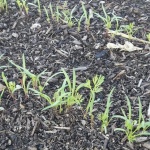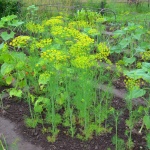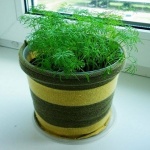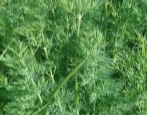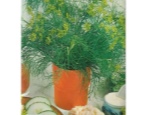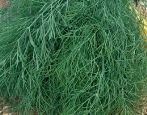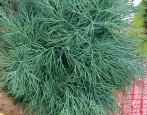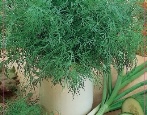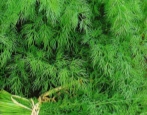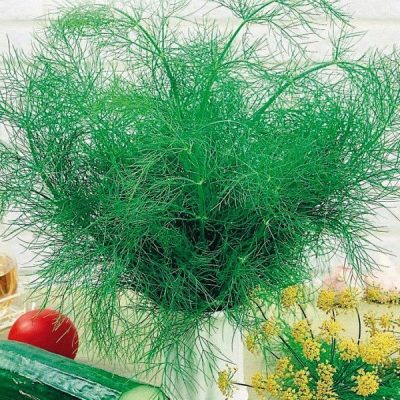
- Authors: Komarova R.A., Mukhanova Yu.I., Trebukhina K.A., Shashilova L.I., Ageenko S.N.
- Year of approval: 1991
- Leaf rosette: half-raised
- Socket height, cm: 30-40
- Ripening terms: late ripening
- The period from germination to biological ripeness (harvesting with spices): 58-72 days
- Foliage: strong
- Leaf size: large
- Leaf color: light green, with a yellowish tinge, with a slight waxy bloom
- Dissection of leaves: 6-7 times
Dill Kibray is a variety that has existed for several decades. Over the years, he managed to fall in love with many gardeners. It is often chosen for its abundant yield and adaptability to cold weather.
Breeding history
The variety was born in 1987 in Russia on the basis of the Federal Center for Vegetable Growing and the Institute of Plant Genetic Resources named after V.I. N.I. Vavilov. In 1991, dill was added to the list of the State Register and became available for mass cultivation.
Description of the variety
This crop is positioned as an independent variety. It stands out among other types of light yellowness, which can be mistaken for a sign of drying out.
Characteristics of the appearance of the plant
Kibray has dense foliage and a voluminous rosette reaching a height of 30-40 centimeters. The leaves are large, long (10-12 centimeters), strongly dissected. The color of the leaves is pale green, with a yellow tint, the surface is barely noticeably covered with wax. The variety does not form inflorescences for a long time. The plant is characterized by a large convex umbrella with a large number of rays (up to 55). When harvested for greens, the weight of the plant is 8-19 grams, when harvested for spices - 15-46 grams.
Purpose and taste
The considered type of dill is used not only fresh, adding to salads and various dishes, but also frozen, dried, or made part of marinades. Kibray brings many health benefits thanks to flavonoids, vitamins, acids. Tasters highly appreciate the taste of this variety, noting that the greens are juicy, aromatic, delicate, palpably spicy, with sweet notes.
Ripening terms
The described variety of dill is classified as late-ripening. Approximately 30-40 days pass from the day of planting seeds to harvesting for greens, and on average 58-72 days before harvesting for spices. It is best to collect Kibray in the morning, after the dew has dried. You need to store dill in the refrigerator, on the bottom shelf. Fresh can stay in excellent condition for up to one month, frozen - up to one year, dried - up to two years.
Yield
The culture is highly productive. On average, a farmer can collect 1.3-3.0 kg for herbs and 2.7-6.3 kg for spices from one square meter.
Growing regions
The geography of distribution of the described species is extensive. It can be found in the North Caucasus, in Eastern and Western Siberia, in the Urals, the Far East, in the Northern, Lower Volga, Central, Middle Volga, North-Western, Central Black Earth regions.
Growing and care
Sowing seeds can be carried out over a long period - from April 25 to mid-July. It is allowed to plant many times, but with an interval of about two weeks.
Experts recommend digging up the beds in advance, in autumn at times, saturate them with humus and infusion of bird droppings, superphosphate. It is good if cucumbers, tomatoes, beans or cabbage were previously cultivated on the selected area.
In the spring, the soil is loosened and irrigated just before planting.The planting material is preliminarily kept in warm water for about a day. The seeds are immersed in the formed grooves to a depth of 1-2 cm.In the process, the distance between the plants is about 20 centimeters, between the rows - 5 centimeters.
Taking care of the plant, it must be systematically watered, loosened and freed from weeds. If Kibray is very yellow, additional feeding (nitrogen or urea) is required. The culture should be moistened regularly, observing a balance: the earth should not crack from dryness or be excessively flooded. Loosening is carried out without exceeding a depth of 8 centimeters.
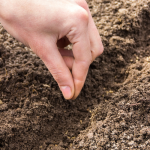
Dill cultivation is available in any conditions: open and closed ground, on a balcony or windowsill. Before planting dill, you need to carry out pre-sowing seed treatment, correctly determine the timing, prepare the beds.
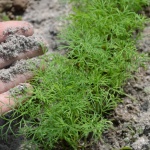
Soil requirements
The culture feels comfortable in loose neutral soil or in soil with low acidity. Groundwater should not be located close to the surface of the earth. But if this happens, it is advised to plant seeds in high beds.
Required climatic conditions
When deciding on a landing site, you should choose an area that is completely open to the sun. In the shade and with a lack of moisture, the plant develops more slowly. It can hardly endure the summer heat. One of the advantages of this type of dill is the ability to grow in cold conditions. Seeds form shoots at a temperature of +3 degrees, the plant develops at 8-10 degrees. If necessary, the variety will survive in a 5-degree frost.
Disease and pest resistance
The considered type of dill shows excellent resistance to many ailments. Sometimes it can be attacked by powdery mildew - snow-white specks on the leaves and stem. To combat pathology, diseased parts of the plant are cut off, and the bed is treated with potassium permanganate or sulfur. In addition, aphids regularly raid Kibray. To combat this parasite, solutions of iodine, ammonia, tar soap, vinegar, onion husks, makhorka, chamomile are used.
Review overview
Dill Kibray was highly appreciated both by experienced farmers and by novice summer residents. They note its remarkable cold resistance, splendor of the bush, aroma, abundant harvest and basic care.
